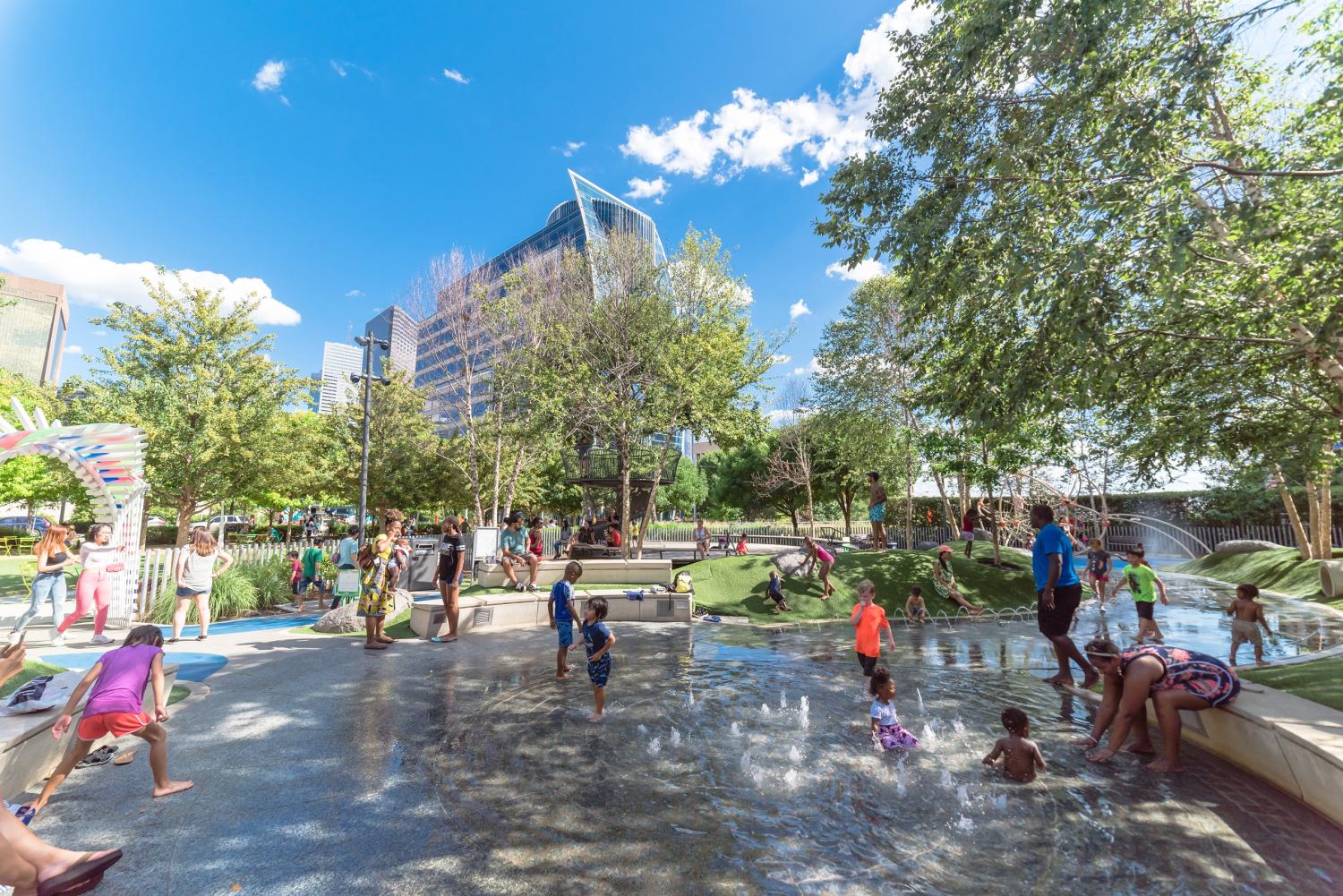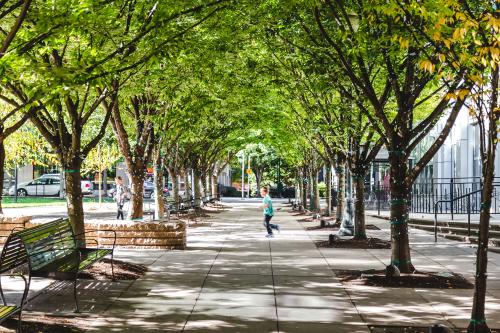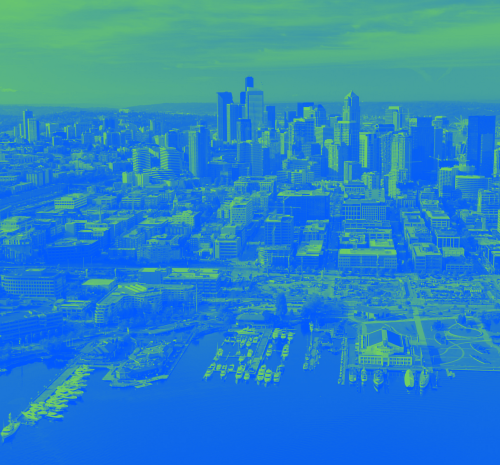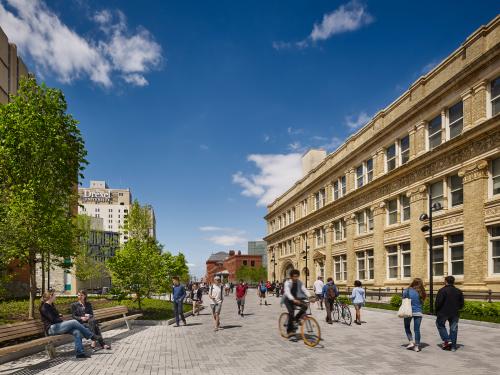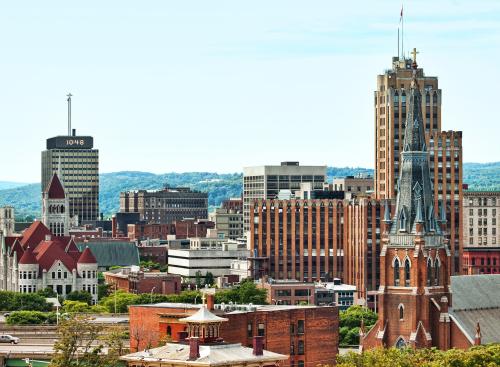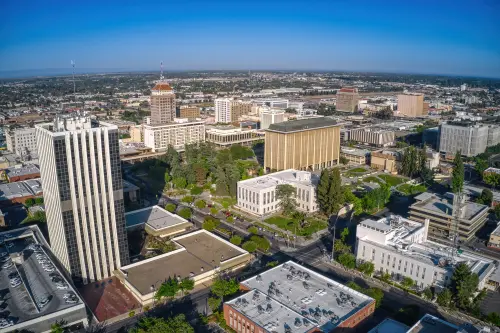After decades of sprawl and suburban dominance, U.S. cities are experiencing rebounding populations, growing employment, and new public and private sector investments in infrastructure, real estate, and placemaking. Much of this revitalization can been found in downtowns, along waterfronts, and in innovation districts where research institutions and entrepreneurs cluster and connect. It is a welcome—and for many communities, long-awaited—upshot of shifting demographics, household structures, and market preferences that are driving higher demand for areas that are walkable, amenity-rich, and which facilitate collaboration among firms and workers.1
But we know that the benefits from these trends are not equally distributed. Market disruptions—from deindustrialization to automation—coupled with a long history of segregation, physical destruction, and disinvestment, are leaving some places out of the revival. Meanwhile, the changing needs of people and businesses are putting some auto-dependent, single use commercial and office districts at risk of becoming obsolete.
And so it’s always been. While the particular technological, market, and social forces that are influencing and enabling these patterns may be new, that the fates of place, people, and economies are deeply intertwined is a truth as old as time. But in an era marked by stark inequalities—by income and wealth, by race and ethnicity, by geography—there is an urgency, and opportunity, for local and regional leaders to embrace and advance place-led development that produces better economic outcomes for more people in more places.
To help deliver on that imperative, the Brookings Metropolitan Policy Program is launching the Anne T. and Robert M. Bass Center for Transformative Placemaking. In collaboration with Project for Public Spaces (PPS), the National Main Street Center (NMSC), and others, the Bass Center will examine the place needs of people and businesses and use that knowledge to help public, private, and civic sectors leaders develop new approaches to creating and supporting concentrations of economic activity that drive inclusive economic growth. The Center is premised on the idea that these “economic districts” represent the geographies in which leaders can have the most transformative impact—where they can build local trust and understanding, experiment safely, show results early and often, and measure impact against a place-centered vision and goals.
There is an urgency, and opportunity, for local and regional leaders to embrace and advance place-led development that produces better economic outcomes for more people in more places.
As PPS often says, “When you focus on place you do everything differently.”
The moment: Place challenges and opportunities
Cities have emerged as a bright spot of democracy in the United States today. With the federal government mired in gridlock and hyper-partisanship, local leaders are stepping up to advance solutions to their unique economic, social, and environmental challenges. As a result, the public maintains high trust in local government while its faith in federal institutions has eroded dramatically.2
Yet this growing empowerment comes at a time of enormous economic tumult. As epicenters of the global economy, cities and metro areas are driving a digital revolution that is transforming demands for jobs, skills, and places. New ideas and innovations are enabling the creation of products and services, from both the public and private sectors that have the potential to improve our health, environment, and quality of life. But the digital economy is also favoring some industries, firms, workers, and communities over others. While virtually all major industry groups and occupations are expanding their use of digital technologies, the degree and speed of adoption vary significantly. As firms differ in their ability to improve their operations and productivity, wage inequality among their employees is rising.3These trends, in turn, are exacerbating the already significant income and wealth gaps that exist between families, particularly between those of different races and ethnicities, at a time when our population is rapidly diversifying.
These inequities are dividing places, too. The digital economy is rewarding large global centers that are attracting innovative companies and highly educated workers, while many older industrial cities and Heartland communities—particularly small and mid-sized cities and rural towns—struggle to keep pace. In fact, between 2010 and 2016, fully half of the country’s employment gains took place in just 20 metropolitan areas, led by New York, Boston, the Bay Area, Seattle, and Washington, D.C., along with fast-growing Sunbelt areas like Dallas, Atlanta, and Orlando.4
Many of these same trends are also playing out within metropolitan areas. On one hand, jobs are continuing to spread out, with low-density suburbs gaining jobs faster than other types of communities.5 On the other, new types of job clusters are emerging or expanding. Take a metro like St. Louis, a once formidable industrial center still struggling to find its economic footing. Although the metro’s overall average job density slightly decreased between 2004 and 2015, several job clusters grew denser during this period.6 The map below shows the concentration of jobs in the city’s central business district, confirming that here—as in metros across the country—the historic core is still a critical hub of its economy. Other significant job clusters that have experienced increases in job density include St. Charles Historic District, the city of Clayton (the St. Louis County seat), and Maplewood, a first suburb with a growing commercial district. The map also shows Cortex, a 200-acre innovation complex not far from downtown. Nestled among major universities and medical centers and rich with cultural and recreational assets, Cortex anchors a dynamic and growing innovation district that serves as a regional center for advanced research, commercialization, and startup activity.

Such constellations of jobs and amenities can be found in metros around the country, in both urban and suburban areas. For example, research by Chris Leinberger and Michael Rodriguez of George Washington University shows that the 30 largest U.S. metro areas together contain 619 “WalkUPs”—regionally significant, walkable communities that have a high density of office and retail space. They find that WalkUP office, retail, and housing rents are significantly higher overall, and growing faster, than those in auto-dependent suburban developments, an indication of the pent-up demand for places built for people instead of cars. Moreover, their research reveals that moderate-income households in the most walkable metros have lower transportation costs and better job access than those in less walkable areas.7
These emerging development patterns hold promise for improving accessibility, fostering increased sociability and civic engagement, and generating job growth, creativity, and innovation.8 Leaders in urban, suburban, and rural communities are thus understandably hungry to better understand and harness the forces behind them to benefit more people and places. They are seeking strategies that scale beyond individual lots or blocks to reinvigorate arts and creative districts, university and medical districts, suburban business parks, Main Streets, and other economic districts. And they want to employ those strategies in ways that help strengthen the broader regional economy and ensure that all citizens can participate in its growth.
But it’s a long way from here to there.
The push and pull of concentration and decentralization over the past two centuries still exert enormous influence on the spatial organization of today’s economy. Auto-centric sprawl—and the associated problems of fiscal waste, environmental degradation, and spatial mismatch between workers and jobs—remains pervasive. At the same time, many existing economic districts—while dense with businesses and jobs—are themselves falling short of their potential. Some districts have legacy design patterns—wide streets, large surface parking lots, blank building faces—that stifle human interaction and sociability. Others may be suffering from decades of disinvestment and decline, with concentrations of human capital, physical, and economic assets that are undervalued by both the private and public sectors. Still other districts are vibrant places where people want to live, shop, and recreate, but which haven’t maximized their assets to spur higher value business and employment growth. Meanwhile, rather than being integral participants in the revitalization of these areas, many residents remain disconnected from new job and market opportunities, or in some very strong market communities, are actually displaced by new place-based investments.
Embedded within these challenges is the certitude that place matters. But how it matters, and who it benefits, varies substantially across regions and the communities within them.
Accompanying this brief are case studies of places that exemplify four types of districts:
- Columbia Gateway, a suburban business park in Columbia, Md. that is implementing a plan to transform itself into a lively district that meets the changing needs of tenants and their workers.
- Chicago’s Bronzeville area, a dynamic and culturally rich community that is well positioned for growth, yet continues to be challenged by the lasting effects of disinvestment, population loss, and discriminatory policies and practices that have stymied economic opportunity.
- Downtown Chattanooga, an innovation district where stakeholders are undertaking intentional efforts to ensure that low-income and minority residents are key participants in the area’s growth and development.
- Newcastle, Wyoming, a rural community with roots in the oil and coal industries looking to diversify its economy through tourism, locally-grown entrepreneurship, and marketing the perks of small-town living.
Transformative placemaking: Leveraging place assets to drive inclusive growth
For decades, planners, community development groups, and other place-focused organizations and practitioners have worked to elevate the importance of place and placemaking in fostering more economically, socially, and environmentally responsible development.
Indeed, over the past several decades the Main Street and smart growth movements have helped leaders understand that reinvesting in existing communities is fiscally and ecologically more sustainable than promoting sprawl. The community development field has long engaged in place-based efforts to revitalize distressed urban neighborhoods and better the lives of their residents. And the work of Project for Public Spaces and other organizations has helped the very word “placemaking” gain ever-increasing currency among community and civic leaders who are working to foster greater community engagement, enhance and activate the public realm, promote better health, or otherwise improve quality of life.
Yet for all their positive impacts, these efforts are constrained by policies, practices, and investment structures that are failing to keep pace with the changing needs of firms, institutions, and workers, hampering the scope and scale of their impact.
“Strengthening the connection between people and the places they share, placemaking refers to a collaborative process by which we can shape our public realm in order to maximize shared value. More than just promoting better urban design, placemaking facilitates creative patterns of use, paying particular attention to the physical, cultural, and social identities that define a place and support its ongoing evolution.” – Project for Public Spaces
For example, local and regional planning organizations may advocate for transportation, economic development, and land use policies and investments to support existing economic districts. But in practice, these investments are often more reactive than strategic, triggered by government or philanthropic programs—like Enterprise Zones, Promise Zones, and most recently, Opportunity Zones—or by private firms, anchor institutions, or other organizations looking for a development site (think Foxconn or Amazon HQ2). Add to this mix the competition for resources and revenues among and within jurisdictions, and you get the sort of scattered, transactional, and uncoordinated development projects that don’t “add up,” in form or function, in ways that help achieve larger economic goals. Further, when public and private sector leaders do more strategically prioritize place-based investments, they often focus on either mitigating the symptoms of entrenched poverty, or on attracting “talent” from out of town. In neither case is inclusive economic growth—that is, business and job growth that benefits everyone—the main objective.
The Brookings Metropolitan Policy Program aims to change this dynamic with the launch of the Anne T. and Robert M. Bass Center for Transformative Placemaking. The Bass Center will focus on three major impact goals:
- Clearly demonstrate and advance the idea that place matters to people and economies. Industry sectors, firms, anchor institutions, workers, and residents have new and varying needs for places and placemaking, and high-quality, connected economic districts can be vital drivers of inclusive growth and development. Through quantitative and on-the-ground research, the Bass Center will explore how and why the spatial patterns of economic growth are changing; the varying types of economic districts that exist or are emerging; and how the particular assets and attributes of districts can influence economic and social outcomes.
- Support the transformation of economic districts with model approaches to inclusive placemaking. The Bass Center will engage stakeholders in a range of economic districts to document and design placemaking practices and programs that leverage their strongest attributes, address their most pressing challenges, and strengthen connections to other communities. These approaches might be targeted toward a specific outcome (e.g., increasing minority entrepreneurship) or focused on supporting broad, district-wide objectives (e.g., long-term place management and financing for district programs).
- Facilitate policy and investment reforms that support place-led economic growth and enable placemaking innovations to scale. The Bass Center will help public, private, and civic sector leaders devise new economic development, land use, infrastructure, governance, and investment strategies that prioritize the development of robust districts, improve connectivity to and between them, and ultimately advance regional economic growth that benefits more people and communities.
Working closely with influential intermediary and advocacy organizations, academic and public policy experts, educators, and philanthropies, the Bass Center aims to be a hub of thought leadership and usable knowledge on the intersection between place, placemaking, and inclusive economic building. Through our work, we hope to inspire leaders to revalue, reimagine, and remake the role of place in today’s economy—to see and do everything a little bit differently.
About the Bass Center for Transformative Placemaking
The Bass Center aims to inspire public, private, and civic sector leaders to make transformative place investments that generate widespread social and economic benefits.
Acknowledgements
The Metropolitan Policy Program at Brookings would like to thank Anne T. and Robert M. Bass for their generous support of the Bass Center for Transformative Placemaking. The Metro Program is also grateful to the Metropolitan Council, a network of business, civic, and philanthropic leaders that provides both financial and intellectual support for the Program.
Brookings is committed to quality, independence, and impact in all of its work. Activities supported by its donors reflect this commitment.
The author is grateful to Chad Shearer and Joanne Kim for their assistance with this brief. She would also like to thank Alan Berube, Amy Liu, Adie Tomer, Julie Wagner, and colleagues at Project for Public Spaces and the National Main Street Center for their careful review and helpful feedback.
-
Footnotes
- Bruce Katz and Julie Wagner, “The Rise of Innovation Districts” (Washington: Brookings Institution, 2014) available at brookings-edu-2023.go-vip.net/essay/rise-of-innovation-districts/.
- See https://news.gallup.com/poll/5392/trust-government.aspx and Isabel Sawhill, “What the forgotten Americans really want—and how to give it to them” (Washington: Brookings Institution, 2018) available at brookings-edu-2023.go-vip.net/longform/what-the-forgotten-americans-really-want-and-how-to-give-it-to-them/.
- Mark Muro, Sifan Liu, Jacob Whiton, and Siddharth Kulkarni, “Digitalization and the American Workforce” (Washington, Brookings Institution, 2017) available at brookings-edu-2023.go-vip.net/research/digitalization-and-the-american-workforce/.
- Mark Muro and Jacob Whiton, “Geographic gaps are widening while U.S. economic growth increases” The Avenue, Brookings Institution, 2018. See also, Economic Innovation Group, “2018 Distressed Communities Index” available at https://eig.org/dci.
- Jed Kolko, “New BLS Data Show Bounceback for Job and Wage Growth in Large Metros; Rural Areas Lag,” Indeed Hiring Lab, March 8, 2017, available at www.hiringlab.org/2017/03/08/new-bls-data-show-bounceback-for-job-and-wage-growth-in-large-metros-rural-areas-lag/.
- Brookings analysis of the Longitudinal Employer-Household Dynamics (LEHD) data. The average job density of St. Louis metropolitan area is weighted by the total number of jobs in each block group. Twenty-four block groups in the region—including those in the circled clusters—had job growth greater than 1,000 jobs and saw their job density increase by at least 50 percent from 2004 to 2015. In 2015, these 24 block groups all met the very high or extremely high job density thresholds established for this analysis.
- Christopher B. Leinberger and Michael Rodriguez, “Foot Traffic Ahead: Ranking Walkable Urbanism in America’s Largest Metros” (Washington: The George Washington University, 2016) available at https://smartgrowthamerica.org/resources/foot-traffic-ahead-2016/.
- See for example, Katz and Wagner, “The Rise of Innovation Districts” and Scott Andes, “Hidden in plain sight: The outsized impact of downtown universities,” (Washington: Brookings Institution, 2017) available at brookings-edu-2023.go-vip.net/research/hidden-in-plain-sight-the-oversized-impact-of-downtown-universities/ and Project for Public Spaces, “What is Placemaking?” available at www.pps.org/category/placemaking.
The Brookings Institution is committed to quality, independence, and impact.
We are supported by a diverse array of funders. In line with our values and policies, each Brookings publication represents the sole views of its author(s).

